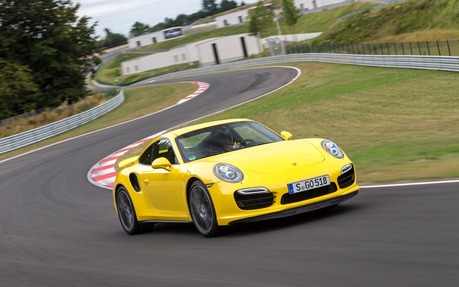2014 Porsche 911 Turbo and Turbo S: 520 or 560 horses?
Start the engine. Press firmly on the brake pedal. Shift into Drive. Activate the Sport Chrono Plus button. Press the accelerator all the way down. Wait until the Launch Control Activated message appears on the dashboard. Hold the steering wheel tightly. Release the brake pedal abruptly.
What happens next will jolt you awake faster than even the strongest espresso ever could: the Porsche 911 Turbo will literally catapult you forward while its four tires grip the asphalt and the all-wheel drive maximizes the transfer of the phenomenal torque deployed by the 3.8-litre six-cylinder biturbo engine. The Turbo goes from 0-100 km/hr in 3.2 seconds, while the Turbo S does the same thing a tenth of a second faster. I told you to hold on to the steering wheel, didn’t I? During this spectacular, almost violent, demonstration of power and torque, the Porsche 911 Turbo displayed masterful poise and perfect stability as the landscape flew by at warp speed.
Later, on the incredible circuit of the Bilster Berg Drive Resort, designed by two-time world Rally champion Walter Röhrl and the Formula One circuit designer Hermann Tilke, the Porsche 911 Turbo excelled with remarkable performances. It takes wide corners at very high speeds, it attacks double bends with panache while remaining stable (even during rapid transitions from one corner to another) and it corrects – almost intuitively – small driving errors.
Rear steering
All this is possible thanks to the electronic systems perfected by Porsche’s engineers; systems whose names always seem to contain at least one of the following words: “dynamic,” “active” or “control.” For example, the Porsche 911 Turbo introduces active steering on the rear axle that includes two electronic servos. They replace the conventional operating arms at the left and right extremes of the rear axle and help vary the angle of the rear wheel according to the car’s speed. At less than 50 kilometres per hour, the wheels shift up to 2.8 degrees opposite from the front wheels, thereby reducing the turning circle and simplifying parking. When going above 80 kilometres per hour, the rear wheels turn up to 1.5 degrees in the same direction as the front wheels, making the car more agile in rapid transitions.
The Porsche 911 Turbo is also equipped with a brand-new active aerodynamics system that adjusts the front and rear spoilers in three modes. At less than 120 kilometres per hour, the front spoiler folds toward the back to reduce friction when entering a garage, for example, and the rear spoiler is in its lowest position. When the car passes 120 kilometres per hour, Speed mode is activated and both outside parts of the front spoiler are deployed while the rear spoiler raises 25 millimetres. At high speeds, Performance mode deploys the central part of the front spoiler to create a low pressure zone under the car’s front end, while the rear spoiler is raised to 75 millimetres and inclines seven degrees toward the front. According to Porsche engineers, Performance mode helps generate 132 kilos of aerodynamic support at 300 kilometres per hour. With the push of a button, you can also manually deploy the aerodynamic features if you just want to make it look like you’re driving at three times the legal limit.
The kitten that roars
Despite its incredible performance potential, the Porsche 911 Turbo also boasts an entirely different facet of its split personality since it’s remarkably docile on signposted roads. On country roads, it shifts to seventh gear in a snap to reduce engine revs and fuel consumption. For example, at 80 km/hr in seventh gear the engine revs at just 1,200 rpm. Plus,when the chassis is set to “normal,” the ride is surprisingly comfortable on back roads. Supercar performance with a peaceful everyday ride is what the new Porsche 911 Turbo has to offer.
The 911 GT3, which is lighter and more agile, is faster on almost all types of circuits – including the Bilster Berg circuit, as Walter Röhrl confirmed – but doesn’t offer as relaxed a ride on public roads.
Do you really need a 520-horsepower (560 for the Turbo S) sports car? Probably not, but if you do, the new 911 Turbos will be arriving in Canada in December 2013 with a price tag of $169,200 for the Turbo and $206,600 for the Turbo S.
| Test drive report | |
| Test model | 2014 Porsche 911 |
|---|---|
| Trim level | Turbo S |
| Price range | $96,200 – $206,600 |
| Price as tested | CA$206,600 |
| Warranty (basic) | 4 years/80,000 km |
| Warranty (powertrain) | 4 years/80,000 km |
| Fuel economy (city/highway/observed) | 13.2 / 7.7 / N/A L/100km |
| Options | N/A |
| Competitive models | Aston Martin Vantage, Ferrari 458, Nissan GT-R |
| Strong points |
|
| Weak points |
|
| Editor's rating | |
| Fuel economy | Fuel consumption improved by 15% compared to the previous version. |
| Value | At $206,600 for the Turbo S, it’s getting expensive. |
| Styling | A classic look and aerodynamic features that move in accordance with your speed: pretty amazing. |
| Comfort | Remarkable for a car with such performance potential. |
| Performance | Astounding. The Launch Control is intense. |
| Overall | We like it a lot, but the GT3 remains the 911 choice for purists. |
